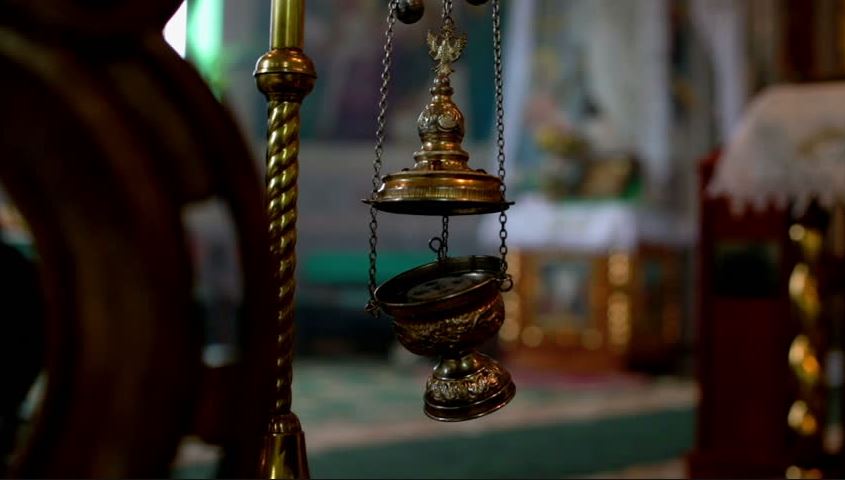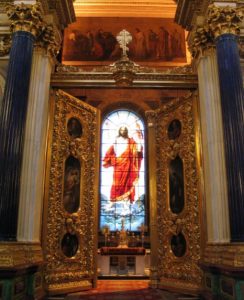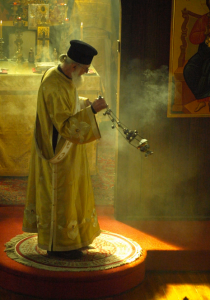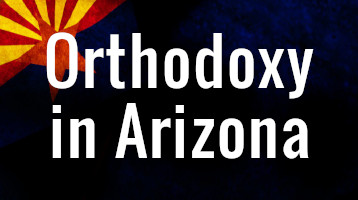
Great Vespers is, for many, their favorite regular service in Orthodox worship. It has great theological meaning, and as the first service at the start of the liturgical day, it has great significance. This article will enrich your experience of Vespers.
The Vespers service (the first service of the liturgical day) is meant to remind us of the Old Testament period, the creation of the world, the first human beings fall into sin, of their expulsion from Paradise, their repentance and prayer for salvation, the hope of mankind in accordance with the promise of God for a Savior and ending with the fulfillment of that promise.
 The service begins with the opening of the Royal Doors and the silent censing of the Altar Table and the entire sanctuary so that clouds of incense fill the depths of the sanctuary. The silent censing represents the beginning of the creation of the world. Without form and void, and the Spirit of God hovered over the original material earth, breathing upon it a life-creating power, but the creating word of God had not yet begun to resound.
The service begins with the opening of the Royal Doors and the silent censing of the Altar Table and the entire sanctuary so that clouds of incense fill the depths of the sanctuary. The silent censing represents the beginning of the creation of the world. Without form and void, and the Spirit of God hovered over the original material earth, breathing upon it a life-creating power, but the creating word of God had not yet begun to resound.
The 103rd Psalm describes the creation of the world and glorifies the wisdom of God. As it is chanted, the priest goes forth from the sanctuary and completes the censing of the entire church and the faithful therein. This sacred action not only remembers the creation of the world, but of the blessed life in Paradise of the first human beings, when the Lord God Himself walked among them. The open Royal Gates signify that at that time the gates of Paradise were open for all people.
To symbolize how man was deceived by the devil and transgressed against the will of God and fell into sin, the Royal Doors are closed. Because of their fall, mankind was deprived of blessed life in Paradise. They were driven out of Paradise and the gates were closed to them. The deacon comes out from the sanctuary and stands before the closed Royal Gates, as Adam did before the sealed entrance into Paradise, and intones the Great Litany asking for peace from above, and to send down upon us “from on high” the peace of Heaven and that He save our souls.
 During the chanting of these verses the deacon censes the church once more. This entire period of the divine service, beginning with the opening of the Royal Gates, through the petitions of the Great Ektenia and the chanting of the psalms, represents the miserable state of mankind to which it was subjected by the fall of our forefathers into sin. With the fall all the deprivations, pains and sufferings we experience came into our lives. We cry out to God, “Lord, have mercy” and request peace and salvation for our souls. We feel contrition that we heeded the ungodly counsel of the Devil. God is asked for the forgiveness of our sins and deliverance from troubles, and all hope in his mercy is placed in God. The censing at this time signifies the sacrifices of the Old Testament and the people’s own prayers as well, which are offer to God.
During the chanting of these verses the deacon censes the church once more. This entire period of the divine service, beginning with the opening of the Royal Gates, through the petitions of the Great Ektenia and the chanting of the psalms, represents the miserable state of mankind to which it was subjected by the fall of our forefathers into sin. With the fall all the deprivations, pains and sufferings we experience came into our lives. We cry out to God, “Lord, have mercy” and request peace and salvation for our souls. We feel contrition that we heeded the ungodly counsel of the Devil. God is asked for the forgiveness of our sins and deliverance from troubles, and all hope in his mercy is placed in God. The censing at this time signifies the sacrifices of the Old Testament and the people’s own prayers as well, which are offer to God.
The Old Testament verses of these psalms of “Lord, I have cried” are alternated with New testament hymns composed in honor of the saint or feast of the day. The last verse is called the Theotokion, or Dogmatikon, since it is sung in honor of the Mother of God, and in it is set forth the dogma on the incarnation of the Son of God from the Virgin Mary.
During the chanting of the Theotokion the Royal Gates are opened, and the Vespers Entry is made. At this time the choir chants a hymn to the Son of God, our Lord Jesus Christ: “O Gladsome Light“. In the hymn, the Son of God is called the Gentle Light that comes from the Heavenly Father, because He came to this earth not in the fullness of divine glory but in the gentle radiance of this glory. This hymn also says that only with reverent voices, and not with sinful mouths, can He be worthily exalted and the necessary glorification be accomplished. The entry reminds the faithful how the Old Testament righteous, in harmony with the promise of God that was manifest in prototypes and prophecies, expected the coming of the Savior, and how He appeared in the world for the salvation of the human race. The censer at the entry signifies that our prayers, by the intercession of our Lord the Savior, are offered to God like incense. It also signifies the presence of the Holy Spirit in the church. The blessing with the sign of the Cross shows that by means of the Cross of the Lord the doors into Paradise are opened again.
Christ is praised as the Light which illumines man’s darkness, the Light of the world and of the Kingdom of God which shall have no evening.
At this time, the prokeimenon is chanted, and on the more important feasts there are readings selections from the Scriptures in which there is a prophecy or a prototype which relates to the event being celebrated, or in which edifying teachings are set forth, which relate to the saint commemorated that day.
Vespers ends with the reading of the prayer of St. Simeon the God-Receiver,
“Now lettest Thou Thy servant depart in peace”
This prayer is followed by the reading of the Trisagion and the Lord’s Prayer, and the singing of the salutation of the Theotokos,
“O Theotokos and Virgin, Rejoice!…,”
or the troparion of the feast, and finally the thrice-chanted prayer of the Psalmist:
“Blessed be the name of the Lord from henceforth and for evermore.”
Then follows the priestly blessing,
“The blessing of the Lord be upon you, through His grace and love for mankind, always, now and ever, and unto the ages of ages.”
The service leads to the meditation of God’s word and the glorification of his love for men. It instructs and allows us to praise God for the particular events or persons whose memory is celebrated and made present to us in the Church. It prepares us for the sleep of the night and the dawn of the new day to come. On the eves of the Divine Liturgy, it begins the movement into the most perfect communion with God in the sacramental mysteries.


